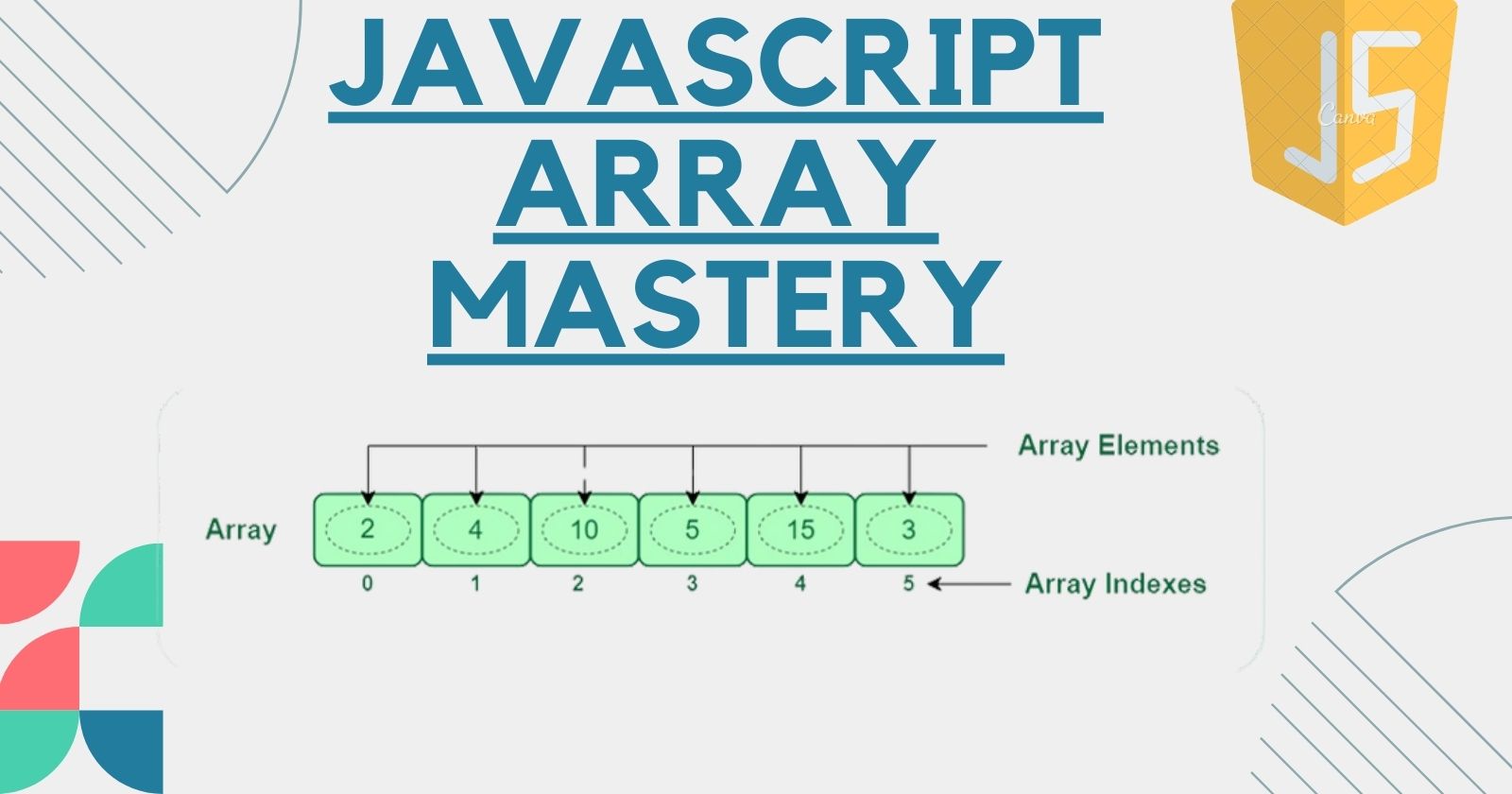JavaScript Array Mastery: 25 Top Methods to Streamline Your Code
 Nikhil Anand
Nikhil AnandTable of contents

Javascript array is a data structure used to store multiple data types such as string , numbers , bigInt , boolean , objects and even another array in a single variable which can help in condense and organize your code . Javascript array is a dynamic , meaning it can grow and shrink its size as needed.
There are two ways to create an array in javascript :-
The array literals , using square brackets [ ].
The array constructors , using new keyword.
Javascript array do not have name/value pairs , instead they are indexed with interger value beginning with 0 and can be accessed by referring the index number of the item in square bracket.
Javascript array is mutable , meaning you can modify their elements after they are created .They offer various methods for iteration , manipulation and transformation of their items. Array methods are build-in features of the javacsript that we can apply to our array , that saves us from writing common function from scratch .
Javascript Methods.
1. Array.map()
This method create a new array by applying function to the each element of the array , this method doesn't modify the existing array. But instead it returns a new array as results of applying function to every element of existing array .
const arr = [101 , 201 , 301 , 401 , 501]
const newArray = arr.map((everyElement) =>{
return everyElement+= 4;
})
console.log(newArray)
// [ 105, 205, 305, 405, 505 ]
2. Array.forEach()
This method execute a provided function once to each element of the array without creating a new array.
const colors = ["red" , "blue" , "green" , "black" , "white"]
colors.forEach((color , index)=>{
console.log(`color at index : ${index} :- ${color}`)
})
// color at index : 0 :- red
// color at index : 1 :- blue
// color at index : 2 :- green
// color at index : 3 :- black
// color at index : 4 :- white
3. Array.every()
This method is used to checks every element in an array passed the certain condition specified by the callback function . It returns ' true ' if all the elements satisfy the condition otherwise return false .
const arr = ["nikhil" , "opensourse" , "mern" ]
const isString = arr.every((element) =>{
return typeof element === 'string'
})
console.log(isString)
// true
4. Array.some()
This method is used to check at least one element in an array satisfies the certain condition specified in the callback function . It returns 'true' if atleast one element satisfy the condition otherwise it returns 'false' .
const arr = ["nikhil" , "opensourse" , "mern" , 2001 ]
const isNumber = arr.some((element) =>{
return typeof element === 'number';
})
console.log(isNumber)
// true
5. Array.includes()
This method is used to check if an array contains a specific element . It returns 'true' if the array contains the element otherwise it returns 'false'.
const niks = ["HTML" , "CSS" , "Javascript" , "NodeJS" , "MongoDB"]
console.log(niks.includes("CSS")) // True
console.log(niks.includes("Typescript")) // False
6. Array.find()
This method is used to retrieve the value of the first element in an array that satisfies the provided condition .
let arr = [45 , 55 , 65 , 75 , 85]
let foundNumber = arr.find((number)=>{
return number > 70;
})
console.log(foundNumber) //75
7.Array.findIndex()
This methods return the index of the first element in an array that pass the test in a testing function.
let arr = ["sun" , "moon" , "stars" , "nikhil"]
let index = arr.findIndex((element)=>{
return element === "nikhil"
})
console.log(index) //3
8.Array.indexOf()
This method is used to find the index of the specified item in an array, It returns the first index at which the element is found in the array or '-1' if it is not present.
let arr = [101 , 202 , 303 , 404 , 505]
console.log(arr.indexOf(404)) //3
9.Array.concat()
This method is used to merge two or more arrays and returns a new array.It does not change the existing array.
let arr1 = [101 , 202 , 303 , 404 , 505]
let arr2 = ["Nikhil" , "opensource" , "WebDeveloper"]
let arr3 = ["Hashnode" , "Nikhil's Blog"]
console.log(arr1.concat(arr2).concat(arr3))
[ 101, 202, 303, 404, 505, 'Nikhil', 'opensource','WebDeveloper','Hashnode',
"Nikhil's Blog" ]
10.Array.join()
This method is used to join the all elements of an array into single string separated by specified operator and returns the resulting string.
let fruits = ["apple" , "orange" , "grapes"]
let result = fruits.join(' , ')
console.log(result) //apple , orange , grapes
11.Array.filter()
This method is used to create a new array with all the element which passes the condition specified in a callback function.
let arr1 = [101 , 202 , 303 , 404 , 505]
let evenArr = arr1.filter((number) => {
return number%2 == 0
})
console.log(evenArr) // [ 202, 404 ]
12. Array.reduce()
This method is used to accumulate or combine elements of an array into a single value. It iterates over each element of an array , applying the callback function and accumulate or combine into single value.
let arr = [101 , 102 , 103 , 104 , 105]
let sum = arr.reduce((total , currentValue)=> total + currentValue)
console.log(sum) //515
13 . Array.fill()
This method is used to fill the array with the static value , starting from the specified index and ending from another specified index.
let arr = new Array(5)
console.log(arr) // [empty,empty,empty,empty,empty]
console.log(arr.fill(25,0,5)) // [ 25, 25, 25, 25, 25 ]
14.Array.slice()
This method is used to extract a section of the array with specified start to end elements and return a new array with the extracted elements.
let arr = [1,2,3,4,5,6,7,8,9]
let slicedArr = arr.slice(3,8)
console.log(slicedArr) // [ 4, 5, 6, 7, 8 ]
15.Array.splice()
This method is used to change the contents of an array by removing or replacing existing element and/or adding new elements in place.
let arr = ["MERN" , "Opensource" , "Development" , "DevOps"]
let removedElement = arr.splice(1 , 1 , "GSOC")
console.log(arr) //[ 'MERN', 'GSOC', 'Development', 'DevOps' ]
console.log(removedElement) // [ 'Opensource' ]
16.Array.reverse()
This method is used to reverse the order of elements in an array.It modifies the original array in place and return the new array.
let arr = ["MERN" , "Opensource" , "Development" , "DevOps"]
let reversedArr = arr.reverse()
console.log(reversedArr) // [ 'DevOps', 'Development', 'Opensource', 'MERN' ]
17.Array.push()
This method is used to adds one or more elements at the end of the array and returns the new length of the array.
let arr = ["MERN" , "Opensource" , "Development" , "DevOps"]
console.log(arr.push("GSOC")) // 5
console.log(arr) // [ 'MERN', 'Opensource', 'Development', 'DevOps', 'GSOC' ]
18.Array.pop()
This method is used to remove the last element from the end of the array and returns the removed elements.
let arr = ["MERN" , "Opensource" , "Development" , "DevOps"]
console.log(arr.pop()) // DevOps
console.log(arr) // [ 'MERN', 'Opensource', 'Development' ]
19.Array.unshift()
This method is used to adds one and more elements to the starting of an array and returns the length of the array.
let arr = ["MERN" , "Opensource" , "Development" , "DevOps"]
console.log(arr.unshift("GSOC" , "AI/ML")) // 6
console.log(arr)
// [ 'GSOC', 'AI/ML', 'MERN', 'Opensource', 'Development', 'DevOps' ]
20. Array.shift()
This method is used to remove the first element from the starting of the array and returns the removed element.
let arr = ["MERN" , "Opensource" , "Development" , "DevOps"]
console.log(arr.shift()) //MERN
console.log(arr) // [ 'Opensource', 'Development', 'DevOps' ]
21.Array.sort()
This method is used to sort the elements of an array in place and then returns the sorted array .The default sort order is ascending order , built upon the element into strings , then comparing the sequences of UTF-16 code unit values.
When applied to an array of string , it sorts the elements alphabetically but for numeric sort , a compare function is required.
// Ascending Order (By Default)
let arr = ["MERN" , "Opensource" , "Development" , "DevOps"]
let sortedArr = arr.sort()
console.log(sortedArr)
// [ 'DevOps', 'Development', 'MERN', 'Opensource' ]
// Decending Order
let arr = ["MERN" , "Opensource" , "Development" , "DevOps"]
let sortedArr = arr.sort((a , b) => b.localeCompare(a))
console.log(sortedArr)
// [ 'Opensource', 'MERN', 'DevOps', 'Development' ]
let arr = [101, 506, 456, 234, 353, 244];
let ascOrder = arr.sort((a, b) => a - b);
let descOrder = arr.sort((a, b) => b - a);
console.log(ascOrder); // [ 101, 234, 244, 353, 456, 506 ]
console.log(descOrder); // [ 506, 456, 353, 244, 234, 101 ]
22.Array.toString()
This method is used to convert an array into a string . it returns a string representing the array elements separated by commas.
let arr = ["MERN" , "Opensource" , "Development" , "DevOps"]
let stringRepresentation = arr.toString()
console.log(stringRepresentation) // MERN,Opensource,Development,DevOps
23.Array.isArray()
This method is used to determine whether a given number is a array or not. It returns true if the value is an array , otherwise , it returns false.
let arr = [1,2,3,4,5]
let notArr = "HelloWorld"
console.log(Array.isArray(arr)) //true
console.log(Array.isArray(notArr)) //false
24.Array.toLocaleString()
This method is used to return the string representing the elements of an array. Each element is converted to a string using the toLocaleString Function , which typically uses locale-specific formatting options( such as date , time , and number formatting ) defined for the user's environment.
let priceArr = [12, 34.89, 765.34, 101, 99.99];
console.log(
priceArr.toLocaleString('en-US', {
style: 'currency',
currency: 'INR'
})
);
// ₹12.00,₹34.89,₹765.34,₹101.00,₹99.99
let arr = [new Date('07 Mar 2024 17:44:06 UTC')]
const localeString = arr.toLocaleString('en', { timeZone: 'UTC' });
console.log(localeString) // 3/7/2024, 5:44:06 PM
25.Array.from()
This method is used to create a new , shallow-copied array instance from array-like or iterable object .
let obj = {
length : 5 ,
0 : "Javascript",
1 : "Java" ,
2 : "Golang" ,
3 : "Python" ,
4 : "C++"
}
let newArr = Array.from(obj)
console.log(newArr)
// [ 'Javascript', 'Java', 'Golang', 'Python', 'C++' ]
Thank You for Reading, Stay tuned for more empowering content! We hope you found valuable insights and inspiration in our blog. Keep exploring, keep learning, and stay curious.
Happy coding! 🚀✨
Subscribe to my newsletter
Read articles from Nikhil Anand directly inside your inbox. Subscribe to the newsletter, and don't miss out.
Written by

Nikhil Anand
Nikhil Anand
Passionate about DevOps engineering and MERN full-stack development, with a strong dedication to advancing open-source initiatives through active contributions.